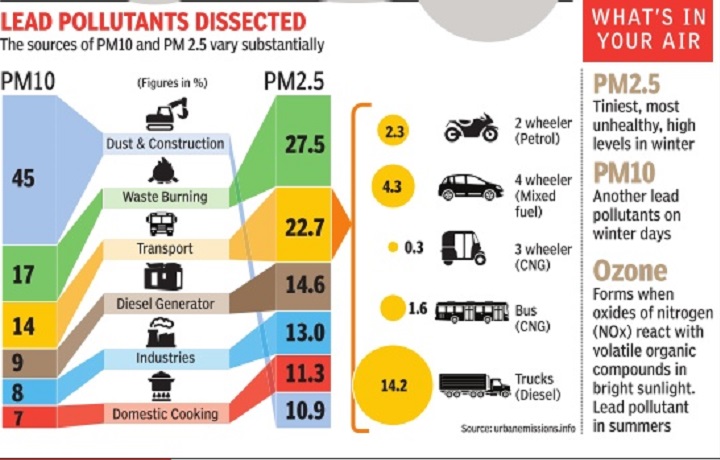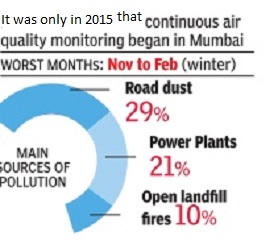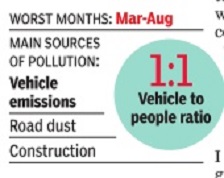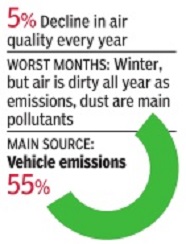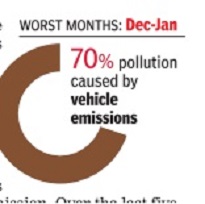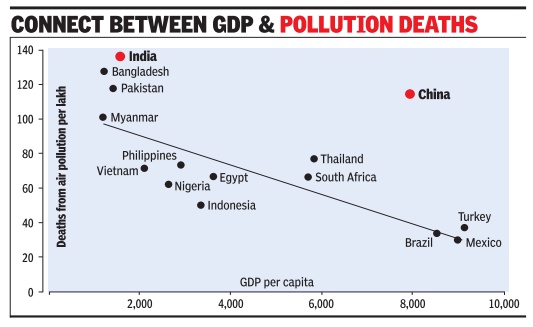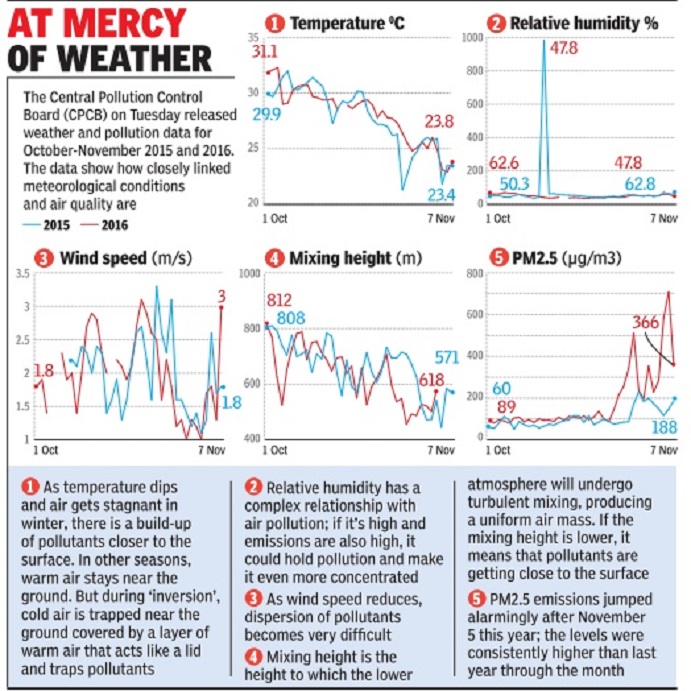Air pollution: India
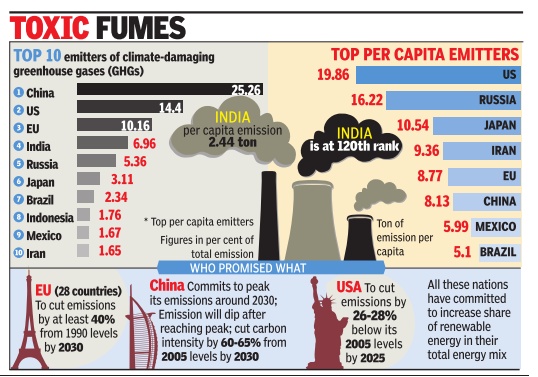
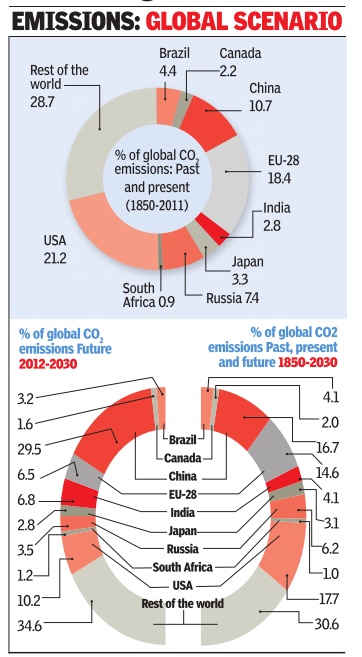
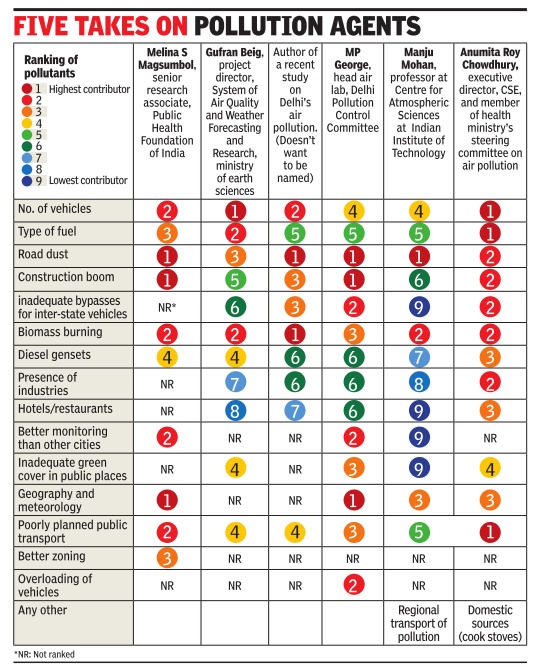
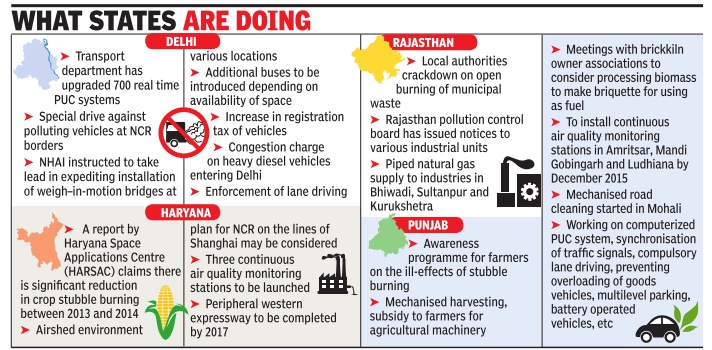
This is a collection of articles archived for the excellence of their content. |
Acid rain
2001-2012: pH levels between 4.77- 5.32
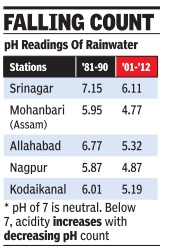
Pollution is causing `life-giving' rain to turn increasingly acidic in many parts of the country , particularly in the last decade, research by India Meteorological Department and Indian Institute of Tropical Meteorology has revealed.
Analysis of rainwater samples from Nagpur, Mohanbari (in Assam), Allahabad, Visakhapatnam and Kodaikanal in the decade 2001-2012 shows a pH level varying between and 4.77 to 5.32, indicating that these places have actually been receiving `acid rain'.
Rainwater with pH below 5.65 is considered acidic.
Potential of hydrogen, or pH, is a scale to measure acidity or alkalinity of a solution, where 7 is `neutral'. For lesser values, acidity increases with decreasing count.
Acid rain is a result of rain water in the atmosphere mixing with polluting gases such as oxides of sulphur and nitrogen emitted from power plants, automobiles and some industrial units.
Acid rain can reduce soil nutrition, corrode buildings (such as Taj Mahal), kill aquatic life and increase heavy metal concentration in soil and water, impacting human health. Acid rain causes leaching of soil nutrients, which means that these nutrients are not available to plants and crops grown in the soil, affecting productivity . Acid rain has had a corrosive effect on monuments,“ experts said.
Acid rain can also dissolve salts of heavy metals found in rocks and soil. These heavy metals then find their way into agriculture fields, water sources and ultimately human physiologies. According to the study by scientists V Vizaya Bhaskar and P S P Rao, which was published in the Journal of Atmospheric Chemistry , almost all global atmosphere watch (GAW) stations in India showed a decreasing trend in pH levels with each passing decade during the period of analysis (1981to 2012).
City-wise
Most cities do not meet national air quality standards
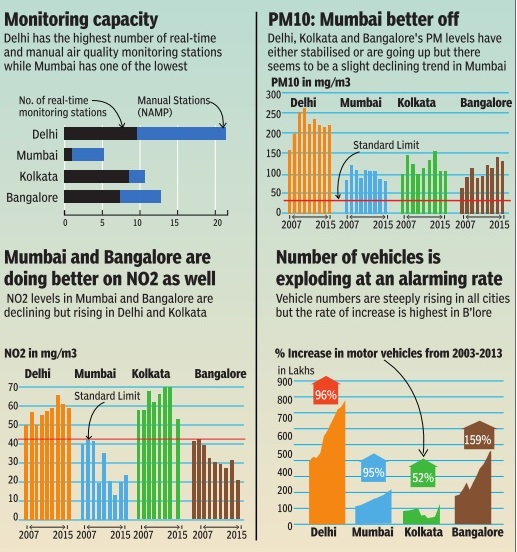
Since 2011, at least 94 Indian cities have not met national air quality standards
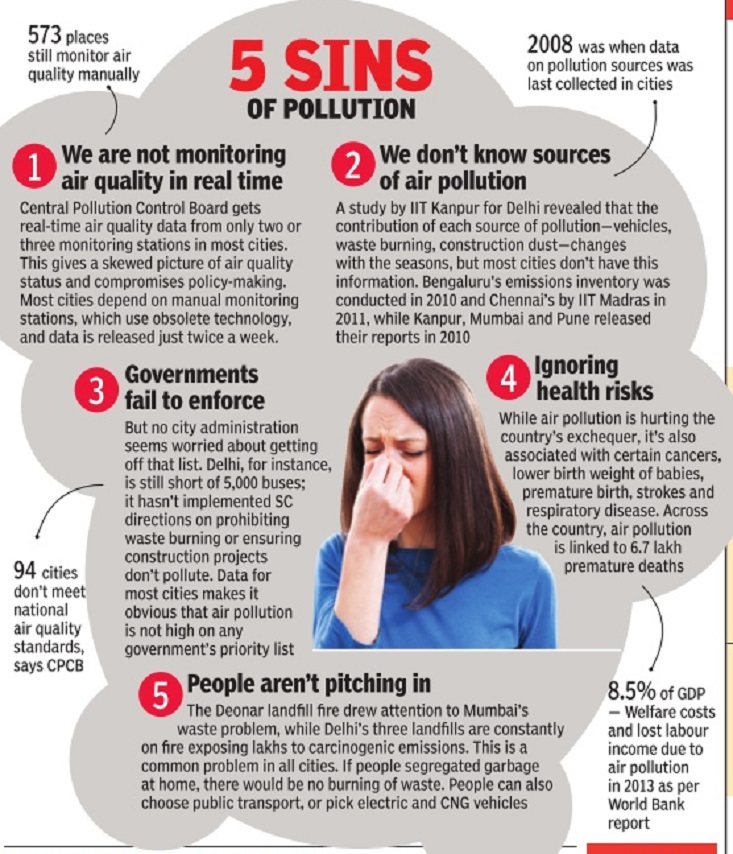
The Times of India
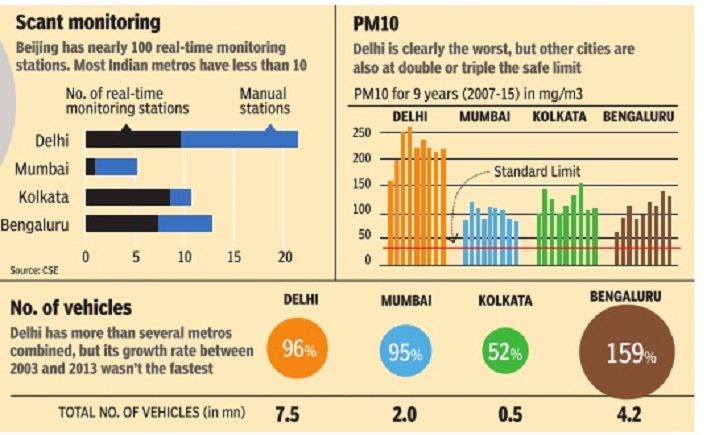
i) The monitoring of air pollution,
ii) PM10 particles in the air, 2007-15,
iii) Total number of vehicles in the city and the growth in the number of vehicles, 2003-13
The Times of India
Jayashree Nandi, Delhi Today, Your City Tomorrow. Nov 06 2016 : The Times of India
94 Cities Haven't Met Air Quality Standards In 5 Years
There's something the hillside retreat of Parwanoo in Himachal Pradesh has in common with the industrial town of Korba in Chhattisgarh--both have consistently recorded higher than acceptable particulate matter (PM) levels.
Since 2011, at least 94 Indian cities have not met national air quality standards. Many of these cities have been on the list from the 1990s, say officials of the Central Pollution Control Board (CPCB).Neither the Centre nor the states have put in place a plan to ensure that cities get taken off this list.The World Health Organisation's recent urban air quality database lists 10 Indian cities among the world's 20 worst polluted. But that doesn't seem to worry the CPCB or administrators either.
For the past couple of years when air pollution in Delhi, Kanpur, Lucknow and Varanasi touched dangerous levels, CPCB did nothing to ensure that its directions on meeting air quality standards were en forced. It also ignored its own studies, commissioned from Chittaranjan National Cancer Institute in 2003, on the impact of air pollution on children over 15 years, which found serious physical and psychological impacts.
The Centre has made only one major decision this year to tackle air pollution--notifying BSVI emission standards for vehicles manufactured after April 2020, which will bring down particulate emissions from vehicles by 60%-80%. The National Air Quality Standard notification, 2009, says safe standards for air should be met 98% of the year, a criterion none of the cities monitored by CPCB meet.Dipankar Saha, additional director, air laboratory at CPCB said: “This is not relevant anymore since we have started real-time monitoring of cities. We alert the nonattaining cities every three years.“
But CPCB only monitors 29 cities real time and has just one continuous air quality monitor at most locations.The rest are manual monitoring machines which are “highly inefficient“ and at times “inaccurate“, say experts.
“Only when there is pressure from the people and the judiciary, cities start acting on pollution. There is no national policy. Even the government's smart city project only makes a passing reference to air quality but doesn't make it binding on cities to meet this criteria,“ says Anumita Roy Chowdhury, head of Centre for Science and Environment's clean air programme. CPCB's air quality bulletins routinely show Faridabad, Agra, Kanpur and Lucknow in “severe“ or “very poor“ categories.
This month for the first time CPCB used its statutory powers to direct municipalities in NCR to take steps to curb air pollution. “The air act gives us statutory powers to issue closure orders or cut electricity or water supply to industries that do not meet norms but it doesn't give us powers to penalize municipalities. So our directions are not binding on them,“ said Saha. In this situation, he is not sure how air quality standards will be met in cities.
“CPCB and state pollution boards have the power to take immediate action,“ insists Kanchi Kohli of Namati Environmental Justice Programme. “They can hold municipalities accountable if they want to.“
DELHI IS THE MOST POLLUTED, BUT OTHER METROS AREN'T GETTING BETTER Nov 06 2016 : The Times of India
Air pollution: Mumbai
See also Air pollution: Mumbai
Mumbai's a coastal city isn't always able to counter the pollutants in the air. On several days in the year, air quality drops into the poor category , and experts say more monitoring and data is needed to ensure it doesn't go the Delhi way. Not all existing monitoring stations are able to give us the right picture because they don't meet the required standards. Having access to data and using it to take precautionary measures is important,“ says Neha Parkhi of Indian Institute of Tropical Meteorology. Local governments claim to have recognized air pollution as a major problem. “Some of the major sources of pollution are smoke from bakeries and burning garbage,“ says Vinayak Karnik, deputy chief engineer, Brihanmumbai Municipal Corporation environment department. The corporation issues an environment status report every August. In its recent report (2015-2016), BMC said the total number of vehicles in the city rose from 25 lakh in 2015 to 27 lakh in 2016, he says. –
--Vinamrata Borwankar
CHENNAI
In humid Chennai's `winter' months of No vember and December, doctors' clinics fill up with patients with respiratory illnesses.The numbers are far lower during in March to August, but those are the months when the PM10 count goes up to 200mcg per cubic metre. Winter may get people coughing, but it's in summer that the air is dirtier. Vehicular emissions, road dust and construction activity (including eight years of work on the Chennai Metro Rail) are major air pollutants. The ratio of people to vehicles is almost 1:1 in Chennai, says Tamil Nadu Pollution Control Board lab director Dr K Rangana than. TNPCB works with the corporation and transport de partment to keep pollu tion in check.
“Chennai's air is clean. Improving g reen cover could further bring down pollution levels,“ says Ranganathan. Air quality at Adyar, a busy residential and commercial locality within easy access of the beach, is the best in the city. It records PM10 count as low as 20mcg per cubic metre--but that could also be because the monitoring device is located at the green Periyar Science and Technology Centre, beside the lush IIT-M campus.
--Abdullah Nurullah
BENGALURU
An unusual combination of a long weekend a dispute over sharing water keeping out fireworks from Tamil Nadu, and activism meant Bengaluru had slightly cleaner air this Di wali compared to previous years. But that's no indication of overall air quality in the city . The annual average increase in levels of respirable suspended particulate matter in the last five years is 5%, according to the Karnataka State Pollu tion Control Board The increasing pollution is in step with the rising number of vehicles: 8% every year. While vehicle emissions are the main source, road and construc tion dust and burning of garbage also contribute “In fact, the air we breathe in Bengaluru is clean only during bandh days,“ says Lakshman, chair man, KSPCB. The problem is the lack of coordinated efforts by various civic agencies.While KSPCB monitors air quality and churns out data, its power stops at issuing notices to various agencies. State governments have failed to set out an action plan to tackle air pollution. Transport department officials said they try to detect pollut ing vehicles. “We have random checks to fine those without pollution under control certificates. It isn't easy as we are short staffed,“ said an official.
--Rohith BR & Aditi Sequeira
KOLKATA
Last week, after Diwali the PM 10 count in Kolkata was 10 times the permissible limit, and though it dropped, it remained at 3.5 times above normal for the next four nights. Every year, pollution peaks after the festival, though the worst months are December and January . The administration has been taking sporadic steps to check pollution. For instance, use of adulterated fuel by autorickshaws, a major source of pollution, was banned. Automatic pollution recording stations have been set up, but monitoring and implementation of norms remain lax.Automatic recording stations often do not work. The three major causes of pollution are vehicle emission, construction dust and industrial emission. Over the last five years, a number of industrial units have been forced to move out of Kolkata or adopt less-polluting methods. Many have switched from coal to LPG. Pollution from construction dust remains a threat since Kolkata is expanding fast and construction activity is on the rise.
--Prithvijit Mitra
Varanasi, Allahabad, Gwalior/ 2015
The Times of India, Dec 13 2016
Jayashree Nandi
Varanasi, Allahabad had no clean air day in 2015
People in Varanasi, Allahabad and Gwalior did not have a single “good air“ day throughout 2015, making these cities worse than Delhi, at least in terms of lack of clean air, according to Central Pollution Control Board (CPCB) data. By contrast, Delhi saw 24 clean air days last year, when PM2.5 concentrations were below 30 mgm3.
The figures were quoted in “Varanasi Chokes“, a report released in Varanasi on Monday that delves deeper into PM Modi's constituency where the air pollution crisis is severe and monitoring lax. The report was presented by IndiaSpend, Centre for Environment and Energy Development and Care4Air at a workshop in the holy city .
Air pollution data for Varanasi and Allahabad were available for 227 and 263 days, respectively , during 2015. Average PM10 (coarse pollution particles) levels in Varanasi have increased steadily between 2010 and 2016.
The report is also being used by civil society organisations to demand action on air pollution and make it an agenda for political parties in the upcoming UP election.
Varanasi has only three air quality monitoring stations with just one online monitoring station that monitors both PM10 and PM2.5. In comparison, Delhi has 13 continuous air quality monitoring stations.
Data for four weeks between October 2015 and November 2015 for Varanasi showed the city's average PM2.5 (fine, respirable pollution particles) levels were at least two to three times the national safe standard of 60 micrograms per cubic metres. Abysmal air quality monitoring infrastructure in these cities is also responsible for lack of focus on controlling emissions in the region, experts said.
The scientists who participated in Monday's conference said that emission sources in the Indo-Gangetic plains had increased massively , contributing to the problem. “There is satellite data to show how aerosol optical depth (pollution particles) has increased rapidly in the last decade in the region. We need tighter emission standards for industries and other sources to control this,“ said S N Tripathi of department of civil engineering at IIT Kanpur.
He added that PM1 (particles of less than 1 micron diameter or superfine particles) levels were nearly as high as PM2.5 emissions around Kanpur. “The sources of PM1emissions are similar to PM2.5 emission sourc es -vehicles, industries, biomass burning and others.“
Tripathi's research team has found PM1 24-hour average to be as high as 300 micrograms per cubic metres, five times the PM2.5 safe standard in Kanpur during winter. The sources of emissions were varied and complex because scientists are seeing the share of secondary particles which are formed from chemical reactions between gases such as sulphur dioxide (SO2) and oxides of nitrogen (NOx) are also very high. Tripathi's findings are significant because PM1 particles can travel to the deepest area of the lungs, pass through the cell membranes of the alveoli, enter the bloodstream, damage the inner walls of arteries.
The report also quotes testimonies of doctors and patients from Varanasi who say there is several-fold rise in health conditions associated with air and water pollution.
2015: improvement, status quo and deterioration in different cities
The Times of India, Jun 02 2016
Jayashree Nandi
Some good news, some bad for 15 major cities on air quality front
A Central Pollution Control Board (CPCB) report on air quality in 15 cities shows that most cities are breaching the national annual safe standard.
While some are seeing a rising trend and some, interestingly, are also showing a decreasing trend in PM 10 (coarse pollution particles) levels, the study also shows that most cities saw an improvement in 2015 compared to previous years. The CPCB concludes in its report that improvement could be linked to implementation of stricter vehicle norms and better fuel quality.
The report was compiled by the CPCB after the NGT in its February 9 order directed it to file an “analysis report“ on pollution levels in all major cities identified by the tribunal.The report is also one of the documents on the basis of which the NGT is spearheading the efforts to reduce pollution in other major cities while an air pollution case pertaining to the Capital is being heard in the Supreme Court.
The NGT asked for more air pollution data from states on Wednesday with details of major sources so that it can come up with effective solutions. The report, which com piles pollution levels from manual monitoring stations in 15 cities, shows that PM 10 levels seem to be falling in Mumbai, Pune, Ludhiana, Amritsar, Chennai while in Lucknow they are stabilising.
There are no clear trends in Bengaluru, Jalandhar, Al lahabad, Kanpur and Kolkata, but PM levels are seen increasing in Hyderabad and Varanasi. “The reason for decrease in PM 10 levels may be implementation of stricter vehicle norms (BS IV),“ the study claims. “The fluctuating trends in some cities co uld be because of vehicles, diesel gen sets, small scale industries, biomass incineration, resuspension of traffic dust and others,“ it said.
Experts, however, said the report is inadequate as it doesn't correlate PM 10 levels with vehicle numbers, establishment of new industries, introduction of cleaner fuels and other interventions.They also pointed that PM 10 is not an effective indicator for pollution caused by combustion sources like vehicles or waste burning. The CPCB should have provided with PM 2.5 data (fine, respirable pollution particles) to give a clearer picture.
BS IV was introduced in NCR, Mumbai, Kolkata, Chennai, Bengaluru, Hyderabad, Ahmedabad, Pune, Surat, Kanpur, Lucknow, Sholapur, Jamshedpur and Agra in 2010.The gradual PM 10 rise in Varanasi could be because it is still on BS III but experts said improvements in Ludhiana, Amritsar or Nagpur cannot be due to better fuel norms.
2017, air quality, city-wise
See graphic
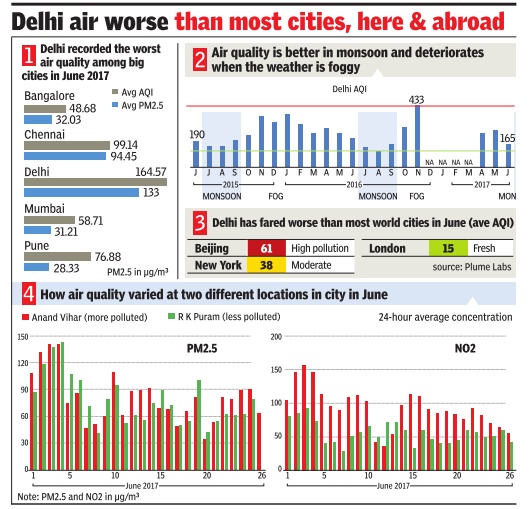
Diwali pollution
See also graphic and Air pollution: Delhi
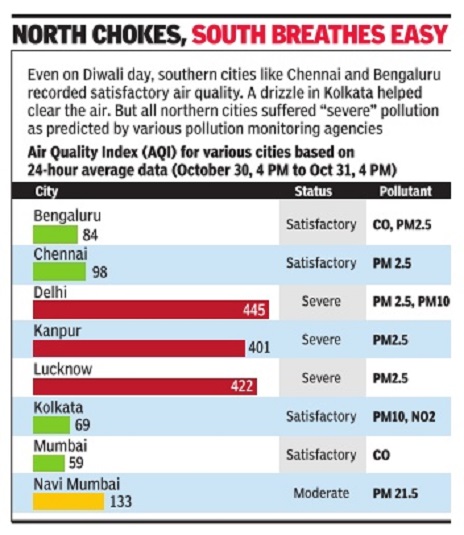
The Times of India
Crackers leave lasting impact on air
Crackers leave lasting impact on air, Nov 02 2016 : The Times of India
Diwali is gone but it seems the toxic pollutants released due to bursting of firecrackers are still hanging in the air. The air quality on Tuesday continued to be in the “severe“ category , according to System of Air Quality and Weather Forecasting Research (SAFAR). The AQI released by Central Pollution Control Board (CPCB), however, showed a slight improvement-“very poor“.
Experts said even if firecrackers were burst only for a day , they left a lingering impact on the air quality because the pollutants were not able to disperse easily as temperatures dropped and the wind speed was very low.
“You have to understand that there were very high intensity emissions over a very short period. While such high emissions can trigger health impacts immediately, they are also adding to the existing pollution, which is not able to escape,“ said a scientist from SAFAR. “The pollutants from this Diwali have started dispersing very slowly and tomorrow dispersion may happen if the wind speed picks up as forecast. But temperature has dropped by a degree, which will make a complete clearout difficult.“ According to SAFAR, PM 2.5 concentrations on Tuesday were about 315 micrograms per cubic metres, about 12 times the WHO standards. “Tomorrow, this could fall to about 240 provided the wind speed improves,“ added the scientist. Wind speed remained very low even on Tuesday , ranging from 2 metres per second in the day to 0.3 metre per second in the evening.
M P George, head of air lab, DPCC, said accumulation of pollutants had begun even before Diwali. “The severe pollution level will have to be seen in the light of prevailing air pollution and meteorological conditions in the past week. The high pollution levels are a result of trans-region movement of pollutants due to crop residue burning, low wind speed and contribution from fireworks on the Diwali night,“ he said.
Economic damage caused by air pollution
2015: killed 81,000 in Delhi, Mumbai; cost Rs 70,000cr
Air pollution contributed to a total of 80,665 premature deaths of adults over 30 years in Mumbai and Delhi in 2015, a two-fold jump from 1995, according to a new study at the Indian Institute of Technology , Bombay .
In economic terms, air pollution cost the two cities $10.66 billion (approximately Rs 70,000 crore) in 2015, or about 0.71% of the country's gross domestic product.
The study has said the impact on health and productivity as a result of exposure to pollution and the consequ ent burden of respiratory ailments rose with every passing decade.
Researchers calculated impact using data on PM 10 (fine particulate matter mea suring 10 microns), population and death rates.
With its higher pollution levels, Delhi recorded more premature deaths due to ingestion of PM10 from vehicle exhaust, construction dust and other industrial processes. Casualties went up from 19,716 in 1995 to 48,651 in 2015.
In Mumbai, the compara tive figure rose from 19,291 to 32,014 in 20 years. Air pollution was also re sponsible for 23 million cases of restricted activity days (RAD) -either less productive days or days off work for individuals -in the commercial capital in 2015.The worsening quality of air in the city also led to 64,037 emergency room visits in 2015 by those stricken by respiratory ailments, up by 35.4% from 1995. In comparison, in Delhi, there were 29 million cases of RAD and 0.12 million emergency room visits in 2015.
The study's lead author, Kamal Jyoti Maji, said the impact of air pollution on health and productivity was evident in that the increase in cases and cost after 2005 was in line with the overall trend in pollution.
Pollution also cost the two cities as much as $10.66 billion in 2015, or about 0.71% of the country's GDP, a cost that's almost doubled since 1995.
The economic cost of PM10 exposure rose by around 60% in Mumbai from $2.68 million in 1995 to $4.26 billion in 2015.Cost to Delhi jumped by 135% in the same period to hit $6.39 billion, the study found.
One measure of health and longevity is called “disabilityadjusted life years“ (DALY), representing years lost due to various illness. This measure for illnesses caused by air pollution doubled in Delhi between 1995 and 2015 from 0.34 million to 0.75 million DALY. In Mumbai, that number rose from 0.34 million to 0.51million DALYs in the same period. To keep to current health outcomes in 2030, PM10 levels would have to decline by 44% in Mumbai and 67% in Delhi, the study said.
These estimates are likely to be an undercount of actual costs, mortality and morbidity , said the researchers, since the study looked only at the impact of PM10 and to a lesser extent PM2.5. The IIT study was published recently in the Environmental Science and Pollution Research Journal, and authored by research scholar Maji, IIT Bombay professor Anil Dikshit and Ashok Deshpande from the Berkeley Initiative in Soft Computing, USA. In India, air pollution causes over half a million premature deaths annually and 20 million DALYs, according to WHO.
Fog in North-Central India (UP, Bihar, Bengal, NCR)
The Times of India, Feb 06 2016
Vaishnavi Chandrashekhar
UP, Bihar, West Bengal see more fog than NCR
When it comes to fog in north India, the large number of flight cancellations helps keep the spotlight irmly on New Delhi. But a new study suggests that the national capital region may not be the area most affected by the phenomenon. The frequency of fog occurrences has increased in the past 15 years in the eastern parts of the Indo-Gangetic plains -including eastern UP, Bihar, West Bengal, Bang adesh, as well as the Nepal Terai -but not in the western parts including Delhi, according to a satellite data analysis by IIT-Bombay researchers led by Ritesh Gautam.
The new findings are surprising because previous research has shown an increase n fog frequency over Delhi and surrounding areaslinked to a rise in humidity and pol ution. By contrast the new study , which was presented at the American Geophysical Union conference in December, found high year-to-year variability in fog occurrence over the Delhi region --linked to variability in weather conditions --but no longterm rise in the past decadeand-a-half.
Gautam, an assistant pro essor at IIT's centre of studies in resources engineering and climate studies, said the divergence could be because most other studies have relied on visibility measurements.
“When the visibility falls to less than one-km, it is classified as fog,“ he said. “But it might just be polluted haze.“
Satellite data has its own limitations. But Gautam said that the team had also found corroborative trends in surface data from 2000-2015.
The increase in fog over the eastern region coincided with a rise in pollution, the IIT analysis also found. Other studies have also shown a ink between increasing winter-time pollution and fogginess. Pollution particles, especially those known as aerosols, attract water vapour, promoting the formation of fog droplets.
In this case, Gautam suggested that the westerlies -winds flowing from north west of India -transport pol lution eastwards, leading to an accumulation over the eas tern Indo-Gangetic plains.
The findings point to the need for broadening fog study beyond the capital region Gautam said. “Although most of north India experiences fog and pollution in winter the focus is mostly on Delhi,“ said the former Nasa resear cher. “There should be incre ased focus over both urban and rural locations in nort hern India.“
Interestingly , a previous study by Gautam's team fo und holes in the fog cover over Delhi and other cities. This could be due to higher tempe ratures from urban heat is lands, the study suggested.
These studies stem from IIT-Bombay's Fog South Asia initiative (fogsoutha sia.com), a satellite monito ring system for fog detection being developed to aid the go vernment in forecasting and transport management.
The initiative is part of a slew of new efforts to decip her an important yet under studied phenomenon in So uth Asia, including the role played by air pollution.
In December, the Indian Meteorological Department and the Indian Institute of Tropical Meteorology started a five-year study of fog in Delhi. The same month, a regional fog study was launched by the International Centre for Integrated Mountain Development (ICIMOD), an intergovernmental think-tank based in Kathmandu. The project is being conducted with the collaboration of scientists across India, Pakistan, Bhutan, Nepal and Bangladesh.
“The issue of fog is such that it cannot be studied locally and thus needs regional cooperation,“ said Bhupesh Adhikary , air quality specialist at ICIMOD.
The project involves collecting pollution and meteorology data in various locations along with satellite-based data, to understand the chemical science. “At the same time, we are also collecting data in small villages to try to understand the social dimension,“ Adhikary said.
While there is no scientific evidence yet about fog in the Nepal Terai, the public perception is that fog is getting more intense and lasts longer, he added.
“Existing forecasting models are from the US and don't show us the entire picture,“ said Sachin Ghude, the IIT-M coordinator for the Delhi campaign, which plans to collaborate with IIT-Bombay .“The goal,“ he said, “is to improve our understanding and fine-tune our models.“
Greenhouse gases
Andhra Pradesh: GHG double between 2005-14
According to an internal assessment by the Andhra Pradesh government, there has been a sharp rise in the greenhouse gas emissions (GHG) from 54 million tonnes of CO2 equivalent in 2005-06 to 103 million tonnes of CO2 equivalent in 2013-14. This is a compound annual growth (CAGR) of 8.4%. Per capita GHG emission increased from 1.16 tonnes in 2005-06 to 2.06 tonnes in 2013-14 in AP.
However, the per capita GHG emissions at all-India level were 1.35 tonnes in 2005 and 1.58 tonnes in 2010. According to the report, agriculture and industry are the major contributors for the GHG. Another major reason is the loss of green cover. Forests have declined from 25% to 13%. An adequate green cover could have helped reduced GHG emissions.
Combining all the components of the energy sector, the total GHG emissions from the energy sector (in CO2 Eq) increased from 43,178 2005-06 to 81,526 2013-14 at a CAGR of 8.27 %. According to documents with TOI, the agriculture sector emitted 17.5 million tonnes of CO2 equivalent, of which 13.2 million tonnes is methane and 4.3 million tonnes nitrous oxide. Enteric fermentation constituted 47% of the total CO2 equivalent emissions. Around 24% of the emissions came from crop soils. Rice cultivation was responsible for 22% emissions. Seven per cent of the emissions were attributed to livestock manure management and burning of crop residue. Top Comment
Fertile delta area of coastal AP is slowly becoming a cement jungles with so much population. Industries! Pollution, rising CO2, increasing humidity are the issues in this region. Lot of initiatives ... Read More Varun Hegde
The report suggested that LED bulbs initiave is expected to save 30-40% energy and slash electricity bills. This will reduce CO2 emission by 50 million tonnes. Similarly, farmers can replace their inefficient pumps free of cost with the new BEE star rated energy efficient sets. These pumps have smart control panel and a SIM card, giving farmers the ability to remote control these devices from their mobile phones. This will reduce CO2 emission by 45 million tonnes yearly. The waste recycling and waste to energy generation policy would reduce domestic and industrial solid waste. The government is going to press into action 50,000 solar water pumps for agriculture purposes.
Health issues
2010, death of 2 people every minute
`Bad air kills two Indians every minute', Feb 20, 2017: The Times of India
Feb 20, 2017: The Times of India
Air pollution is killing two people in India every minute with the country's environment turning more toxic by the day , says a new study published in the journal `The Lancet'. According to the study , some of the worst polluted cities of the world are in India.
The study , released in Feb 2017 but based on 2010 data, week but based on 2010 data, estimates that, globally , 2.73.4 million preterm births may be associated with exposure to PM 2.5. South Asia, with 1.6 million preterm births, is the worst hit, the study adds.
Released by 48 leading scientists, the study adjudged Patna and New Delhi the world's worst polluted cities by levels of PM 2.5, micro particles that can enter the bloodstream and damage the respiratory system.
The study says even safe level of air pollution in harmful
The report also adds that household air pollution that results from use of solid fuels and other biomass contributes to around 4.3 million deaths annually
In the report, Patna and Delhi figure among the most polluted cities, both having an annual PM 2.5 concentration of more than 120 micrograms per cubic metres — about 12 times the WHO guideline. The WHO annual PM 2.5 guideline is 10 micrograms per cubic metres. This IEA report had sourced data from the World Health Organisation (WHO's) urban air quality database of 2016.
"An estimated 18,000 people die every day because of exposure to ambient and household air pollution, making it the world's largest single environmental health risk. Ambient air pollution is particularly pertinent in urban areas, but it also affects non-urban populations," the Lancet Countdown states. "About 80% of people living in urban areas around the world are exposed to air pollution levels in excess of WHO guidelines. This number rises to 98% for urban populations in low-income and middle-income countries," the countdown states.
The report also adds that household air pollution that results from use of solid fuels and other biomass contributes to around 4.3 million deaths annually, which are related to pneumonia, stroke, lung cancer, heart disease, and chronic obstructive pulmonary disease (COPD). The Lancet Countdown will report annually in The Lancet journal. The institutions involved in the project includes bodies such as University College London, Tsinghua University and the Centre for Climate & Security among others. They have collaborated with the World Health Organization (WHO) and the World Meteorological Organisation (WMO) too. The report underlines that air pollution and climate change are related and addressing air pollution will have climate change benefits too.
2012-14: Cases increase, deaths decrease
The Times of India, Sep 23 2015
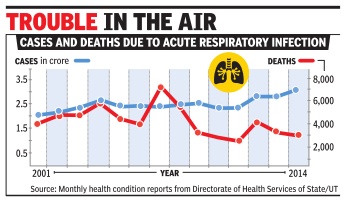
Sushmi Dey
Respiratory disease cases rose by 5m since 2012: Govt
Air pollution may be posing a rising health risk in India as the number of cases of acute respiratory infection (ARI) have risen by five million since 2012 even though deaths have declined in the same period, government data released on Tuesday evening shows. Cases of ARI have been rising even before 2012, though deaths began to decline since that year.
The government report notes the strong association between air pollution and respiratory diseases. While ARI cases rose by five million, deaths due to the condition reduced marginally . As many as 2,932 people died due to ARI in 2014, as against 3,513 in the previous year, according to the `National Health Profile 2015' released by health minister J P Nadda. The report's profile stated that air pollution leads to a wide array of health effects, of which ARI “has accounted for the maximum number of cases“ while noting that “over the years, ARI cases are showing an increasing trend“.
The increasing trend in number of ARI cases is clear ly discernible since 2011. The National Health Profile 2015, published by the Central Bureau of Health Intelligence (CBHI), covers demographic, socio-economic, health status and health finance indicators, along with comprehensive information on health infrastructure and human resources in health.
Around 3.5 crore ARI cases were reported in 2014, out of which 1.7 crore were females and 1.8 crore were men, the data shows. TOI had earlier reported that on an average, more than 2.6 crore cases of ARI were reported in India ev ery year, whereas over 35,000 people died due to the air pollu ion-linked disease in close to 10 years. The data was presented by the environment minis ry to Parliament during the monsoon session this year in a rare official admission that pollution could be causing deaths on a large scale.
However, global studies have attributed far more deaths o air pollution in India. A WHO assessment, reported by TOI in May , showed India and China as worst-hit countries compared to the global average of deaths due to air pollution. It also noted that pollution is sharply increasing in develop ng countries leading to various serious health problems.
In Delhi, close to 3,39,506 ARI cases and 104 deaths were reported in 2014. However, deaths due to the disease in UP and Bengal were much higher, at 619 and 625, respectively.
2013: 1.4 million lives lost
The Times of India, Sep 09 2016
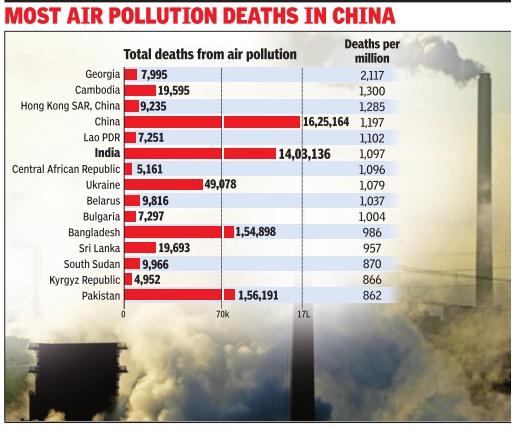
Atul Thakur
1.4m lives lost in India due to air pollution in 2013: Study
India lost 1.4 million lives to air pollution in 2013, while in China the toll was 1.6 million, estimates a World Bank report released. The report, released by the World Bank and the Institute for Health Metrics and Evaluation, shows that in 2013 more than five million deaths worldwide were attributed to health conditions caused by air pollution. About 60% of them were in the world's two most populous countries.
Exposure to air pollution increases a person's risk of contracting ailments such as lung cancer, stroke, heart disease and chronic bronchitis.
China and India aren't among the worst hit in absolute terms because of the sheer size of their respective populations. Even after adjusting for population, these two countries along with Bangladesh, Sri Lanka and Pakistan were among the 15 nations with the highest toll per million population.
China and India ranked 4th and 6th worst in the world respectively . Bangladesh, Sri Lanka and Pakistan were ranked 11th, 12th and 15th on this count.
The bank estimates that in 2013 Georgia saw the highest rate of air pollution deaths per million of its population at 2,117. It was fol lowed by Cambodia with a death rate of 1,300 per million.
Among the 142 countries for which the bank complied this data, there were 10 where the rate was higher than 1,000 deaths per million. Australia fared best on this parameter with an estimated death rate of 34 per million.
The report also estimat ed that air pollution cost the world economy more than $5 trillion -purchasing power parities (PPP) at 2011 prices -in welfare losses and an additional $66 billion worth of manpower loss.
China's overall welfare and manpower loss was $1.6 trillion while India lost more than $560 billion, which was equivalent to over 10% of China's and 8.5% of India's GDP .
Air pollution is estimated to be the fourth leading fatal health risk worldwide after metabolic risks, dietary risks and tobacco smoke. The estimates are based on exposure to PM2.5 pollutants. It is noticeable in the report that the risks are much higher in the developing world.
By damaging people's health and causing fatal diseases, air pollution can have a lasting effect on a person's economic productivity .
Experts argue that typically the economically weakest section is the worst hit because of limited access to health care facilities. Thus, exposure to bad air quality and other risks will ultimately widen the existing economic inequalities, they say.
2013-14: Report "Hidden Price Tags/ impact on health"
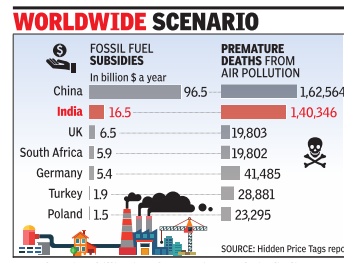
Cost To Fight Such Diseases Stands At Rs 141 Billion: Report
India spent $16.9 billion on oil, gas and coal subsidies in 2013 and 2014 but the health costs to meet the burden of air pollution-linked diseases was eight times more at $140.7 billion, says a report by an European environmental non-profit organisation.
The Health and Environment Alliance (HEAL) assessed the spending of seven economically powerful countries on fossil fuel subsidies, and the health costs associated with fossil fuel subsidies.
The report, `Hidden Price Tags', said India can provide 375 million households with solar lamps or train nearly 32,000 extra doctors for rural areas with its annual spend on fossil fuels subsidies. This was assessed considering that each solar lamp costs about $22.5 and the recent estimate of All India Institute of Medical Science which put the cost of training a doctor at Rs 1.7 crore. The subsidy amount could fund 24% of the total money needed to implement healthcare coverage for all Indians, the report suggests.
Making a case for spending fossil fuel subsidy money on public health instead, the report released on Thursday claimed that G20 governments spent about $444 billion in subsidies to fossil fuel companies in 2014, but the health costs of these subsidies in the form of respiratory and cardiovascular diseases, as well as premature deaths, were as high as $2.76 trillion, six times the subsidy amount.
The report calls for reallocation of fossil fuel subsidies because they increase the price gap between fossil fuels and renewables, which makes fossil fuels seem cheaper and discourages investment in green energy .
HEAL has used a combination of data provided by the International Monetary Fund (IMF), the Overseas Development Institute (ODI) and Oil Change International (OCI) to arrive at their findings. For subsidy estimates, data from ODI and OCI were used for 2013 and 2014, which includes national subsidies delivered through direct spending and tax breaks, investments by state owned enterprises and public finance from government owned banks.
On India's spending on fossil fuel subsidies, researchers from the Public Health Foundation of India (PHFI), who drafted the India chapter, noted that two-thirds of electricity in India continues to be generated from coal, one of the biggest contributors to air pollution. Liquefied Petroleum Gas (LPG) and kerosene were also subsidised.
The report said not all fossil fuels are bad. In fact, LPG has significant health benefits when used to substitute biomass or coal as cooking fuel.“About 400 million households have been helped to make the switch from burning solid fuels to the healthier LPG option with the help of subsidy schemes since 1980.
But population growth has resulted in over two-thirds of households burning highly carbon-emitting biomass fuels for cooking with resulting health impacts,“ the report states. That India has ambitious renewable energy targets of meeting over 50% of installed power capacity with renewable energy by 2027 is encouraging, authors said.
On kerosene, the authors noted that “as much as half of the subsidised kerosene is simply sold on the black market since it can be used in diesel engines.“ Kerosene is “poor man's fuel“ used by millions of households in rural India to meet basic lighting needs. Government subsidies make the fuel more affordable.They said kerosene smoke is rich in black carbon and kerosene poisoning among children remains a concern. China spent about $96.5 billion on fossil fuel subsidies and its associated health costs are $1,785.4 billion, 19 times the subsidy amount.
India accounts for 75% of air pollution casualties in SE Asia
Nine out of 10 people in the world are breathing poor quality air, a new report by the World Health Organisation said calling on countries to take action against air pollution which is causing over six million deaths a year globally .With the use of new interactive maps, the UN agency found 92% of the world's population living in places where air quality levels exceed WHO limits.
India accounts for 75% of the 8 lakh air-pollution related deaths annually in the South East Asia Region, whereas 90% of the world's casualties from poor air quality are in low-and middle-income countries, the maps show identifying specific areas where pollution levels are extremely high.
The UN agency's report said 94% of the pollution-related deaths in lowand middle-income countries are due to non-communicable diseases like cardiovascular diseases, stroke, chronic obstructi ve pulmonary disease, lung cancer. Air pollution also increases the risks for acute respiratory infections.
Over 6 lakh people die in In dia every year of ailments caused from air pollution such as acute lower respiratory infection, chronic obstructive pulmonary disorder, ischemic heart disease and lung cancer.
The report represents the most detailed outdoor (or ambient) air pollution-related health data, by country , ever reported by WHO. The model is based on data derived from satellite measurements, air transport models and ground station monitors for more than 3000 locations, both rural and urban. It was developed by WHO in collaboration with the University of Bath in UK.
According to the report, the problem of air pollution is most acute in cities, but air in rural areas is worse than many think and poorer countries have much dirtier air than the developed world, it said.
Air pollution and premature deaths
As countries become richer, air pollution-related deaths reduce. This is the general trend for most nations except India and China, a report released by Greenpeace has found. The study , which assesses the GDP per capita versus deaths resulting from toxic air, revealed India and China had higher death rates than what is expected of countries with similar per capita GDP .
The report states that air pollution may have caused 1.6 million additional deaths than a projected death number based on GDP growth rate for 2015 in India and China collectively .The report sources the number of such deaths from the Global Burden of Disease report and GDP per capita estimations for all countries from a recent World Bank document.
“Usually , air pollution has an inverse relationship with the GDP . As countries become richer, they generally develop less polluting industries. But in India and China, the trend has been quite the opposite. An economy heavily reliant on coal can only spell doom for its people,“ said Lauri Myllyvirta of Greenpeace East Asia.
Although air pollution death rates have fallen in China and India since 1990, they are still worse than most similar countries. In India, rates have not improved since 2010. In 2015, pollution claimed 138 and 115 lives per 1 lakh people in India and China, respectively .
According to its GDP per capita, the expected death rate in India is 94 per lakh but its death rate remains 138. “So, unlike China, it hasn't yet reached an income level where its air pollution death rate could be expected to be similar to that in rich nations. But in both cases, there is potential for significant improvements in air pollution death rates,“ said Sunil Dahiya of Greenpeace India.
2017: Rate of death higher in India than China
Vishwa Mohan, Feb 15, 2017: The Times of India
Country Can't Continue In Denial: Experts
India has been in denial mode on linking premature deaths to air pollution in the absence of conclusive data, but a new comprehensive global report by two US-based institutes may now trigger a rethink. The report claims the country's worsening air pollution caused some 1.1 million premature deaths in 2015 and it now rivals China in having among the highest air pollution health burdens in the world.
The State of Global Air 2017 report, released in Boston, claims longterm exposure to fine particulate matter (PM2.5) -the most significant element of air pollution -contributed to 4.2 million premature deaths in the world in 2015 where both India and China to gether were responsible for over half of the total global deaths. Though the report sounds alarm bells for entire Asia, it paints a particlularly grim picture for India where the rate of increase of premature deaths due to air pollution is even higher than in China. It noted that while the early deaths related to PM2.5 in China has increased by 17.22% since 1990, it has increased by 48% in India.
Ozone-related early deaths in India are, in fact, 33% higher than those recorded for China. India's deepening pollution problem, which hit home with a vengeance after Diwali last year as Delhi and NCR woke up enveloped in smog that refused to lift for days, has a death toll second only to China's, and together the two nations acount for over half the world's deaths from pollution.
According to the State of Global Air 2017 report, released in Boston, as many as 2.54 lakh deaths occurred in 2015 on account of exposure to ozone and its impact on chronic lung disease.India accounts for the highest number of premature deaths due to ozone pollution, its toll 13 times higher than Bangladesh's, and 21 times higher than Pakistan's.
An interactive website on the report also highlights that 92% of the world's population lives in areas with unhealthy air. “We are seeing increasing air pollution problems worldwide, and this new report and website details why that air pollution is a major contributor to early death,“ said Dan Greenbaum, president of the Health Effects Institute (HEI), the research institute that designed and carried out the study . He said, “The trends we report show that we have seen progress in some parts of the world, but serious challenges remain“.
The report was prepared by HEI in cooperation with the Institute of Health Metrics and Evaluation at the University of Washington and the University of British Columbia. Involving more than 2,000 researchers, the report factored in the role of an extensive set of behavioural, dietary and environmental risk factors for more than 300 diseases in 195 countries from 1990 onwards.
Referring to the findings of the report, Anumita Roychowdhury of the Centre for Science and Environment, said, “India can't afford to remain complacent or in denial. With so many people dying early and falling ill... due to particulate and ozone pollution, it is a state of health emergency . This demands nationwide intervention to ensure stringent mitigation and a roadmap to meet clean air standards“.
Industrial pollution
Effect on rainfall
[http://epaperbeta.timesofindia.com/Article.aspx?eid=31808&articlexml=THREAT-TO-CROPS-Bad-air-to-blame-for-03072017002042 Jayashree Nandi| Jul 03 2017 : The Times of India (Delhi)]
It's not just your lungs that the city's bad air is hurting. A study , published in the Atmospheric, Chemistry and Physics journal, has highlighted how air pollution could delay rains in some areas, on one hand, and cause intense rain in a relatively short period, on the other.
This -and several other similar studies -drives home how air pollution may already be impacting crop yields and food production.
The study carried out by IIT-Kanpur, Weizmann Institute in Israel and Indian Meteorological Department has assessed long-term data of clouds, aerosols and rainfall from June to September between 2002 and 2013. “Satellite modelling studies showed that aerosols caused formation of a large number of cloud droplets that are relatively smaller in size. These release a lot of energy , or latent heat. Then, the droplets are pushed vertically , crossing the freezing line. This is also an energy-extensive process that fuels cloud growth,“ said professor SN Tripathi of department of Centre for Environmental Science and Engineering at IIT-Kanpur.
In simple terms, he explained, “more aerosols can cause intense rain in a relatively short period. It can also delay the onset of rain during monsoon“. Aerosol Optical Depth -the degree to which aero sols (airborne solid and liquid particles) prevent transmission of light in an area -is also considered an indirect proxy for air quality. In this study, scientists found AOD in the summer monsoon region during the monsoon months to be 0.6. There is no safe stan dard for AOD, but in cleaner areas such as in the US, the AOD is about 0.1.
A study by Princeton University in 2011 had indicated that monsoon rain was decreasing over the years, mainly because of anthropogenic aerosol emissions.
Professor Sagnik Dey , associate professor at Centre for Atmospheric Sciences at IIT-Delhi, said: “The frequency and intensity of rainfall during monsoon is getting affected. When it's raining, it's raining very heavily and the monsoon is often not progressing smoothly .The aerosol load is higher over the Indo-Gangetic plains, the heating gradient is higher and the cloud patterns are also changing.“
According to Pallavi Pant, a US-based scientist: “The role of aerosols in rainfall is quite complex. Presence of particles in the atmosphere can influence cloud formation because they can act as nuclei or seeds for clouds to form. In some cases, a higher number of particles in the atmosphere can result in heavier rainfall.“
Action taken against polluters
2017: CPCB shuts 387 units in UP
Maria Khan, CPCB shuts down 387 polluting units across UP, August 28, 2017: The Times of India
The Central Pollution Control Board (CPCB) has issued directions to shut down 387 industrial units across Uttar Pradesh after inspections found that they had been violating pollution control norms. According to the CPCB report, the industries, which range from tanneries to textile mills, sugar mills to chemical processing plants, have been discharging effluents directly or indirectly into the Ganga and its tributaries, thereby contam inating the water.
Based on reports, the board on August 9 had issued closure directions to 433 defaulting units across the state under Section 5 of the Environment (Protection) Act, 1986. Of these, 46 grossly polluting industries (GPIs) have since complied with the directions and have been issued revocation directions. The remaining 387 have either not complied with the directions relating to online effluent monitoring devices or have found to be not complying with prescribed standards. In the list, which was re ceived by district authorities on Saturday , textile units make the largest number of those which are to be shut down, at 224. Tanneries number 118. Also in the list are 11sugar mills; 10 distilleries; nine food, dairy and beverage processing units; six chemical units and two slaughterhouses and paper mills each.
Additional district magistrate (enforcement), SP Singh told TOI, “The process of shutting them down has already begun.“
Kitchens’ air pollution
Effect on rainfall
THREAT TO CROPS - Bad air to blame for irregular rain
New Delhi It's not just your lungs that the city's bad air is hurting. A study , published in the Atmospheric, Chemistry and Physics journal, has highlighted how air pollution could delay rains in some areas, on one hand, and cause intense rain in a relatively short period, on the other.
This -and several other similar studies -drives home how air pollution may already be impacting crop yields and food production.
The study carried out by IIT-Kanpur, Weizmann Institute in Israel and Indian Meteorological Department has assessed long-term data of clouds, aerosols and rainfall from June to September between 2002 and 2013. “Satellite modelling studies showed that aerosols caused formation of a large number of cloud droplets that are relatively smaller in size. These release a lot of energy , or latent heat. Then, the droplets are pushed vertically , crossing the freezing line. This is also an energy-extensive process that fuels cloud growth,“ said professor SN Tripathi of department of Centre for Environmental Science and Engineering at IIT-Kanpur.
In simple terms, he explained, “more aerosols can cause intense rain in a relatively short period. It can also delay the onset of rain during monsoon“. Aerosol Optical Depth -the degree to which aero sols (airborne solid and liquid particles) prevent transmission of light in an area -is also considered an indirect proxy for air quality. In this study, scientists found AOD in the summer monsoon region during the monsoon months to be 0.6. There is no safe stan dard for AOD, but in cleaner areas such as in the US, the AOD is about 0.1.
A study by Princeton University in 2011 had indicated that monsoon rain was decreasing over the years, mainly because of anthropogenic aerosol emissions.
Professor Sagnik Dey , associate professor at Centre for Atmospheric Sciences at IIT-Delhi, said: “The frequency and intensity of rainfall during monsoon is getting affected. When it's raining, it's raining very heavily and the monsoon is often not progressing smoothly .The aerosol load is higher over the Indo-Gangetic plains, the heating gradient is higher and the cloud patterns are also changing.“
According to Pallavi Pant, a US-based scientist: “The role of aerosols in rainfall is quite complex. Presence of particles in the atmosphere can influence cloud formation because they can act as nuclei or seeds for clouds to form. In some cases, a higher number of particles in the atmosphere can result in heavier rainfall.
25% urban households don't have kitchen
Could you please give a link to this page on the Housing and UD page but not vice-versa? Dipak Dash, 1.7cr households in cities have no kitchen , April 12, 2017: The Times of India
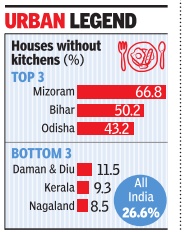
At least one-fourth of urban households in India don't have separate a kitchen, according to data based on the Socio-Economic Caste Census (SECC) carried out by the housing ministry .
The survey indicates how nearly 1.7 crore urban households may be using their single room for cooking food as well.This fresh data gains importance considering that different studies have shown how air pollution in kitchens has become a major health concern and that too in urban areas where the ambient air is getting increasingly polluted due to vehicular emission and dust.
A study published in Elsevier, a journal on environmental research, which assessed people's personal ex posure to pollution in Delhi, showed how kitchens can be more polluted than roads.
The study mentioned how urban households, particularly kitchens, could be enveloping people in PM 2.5 pollutants as well. Other studies across the globe have also shown how kitchen appliances release colourless pollutants. Kitchens also get more polluted when they lack proper ventilation. In fact, the Pradhan Mantri Ujjwala Yojana (PMUY), launched by PM Narendra Mod, was a big step towards making kitchens smoke-free for women who are often the worst-affected by such pollution.
According to SECC data, while Mizoram has the maximum percentage of such households, Bihar ranks second. In Daman and Diu and Kerala, over 90% households have exclusive kitchens.
SECC data shows that in 2011, when the survey was conducted through a comprehensive door-to-door enumeration across the country , nearly 24.5% of urban households had a single room.
Sources in the housing ministry said the SECC data collected in 2011 is being utilised in sanctioning houses for the urban poor with central aid under the Pradhan Mantri Awas Yojana. SECC data, which conceals sensitive caste and poverty details in urban areas, gives details of how many families are “houseless“ and how many live in rented accommodations in towns and cities.
Link between meterological conditions, air quality
See graphic.
Measurement of Air Quality
National Air Quality Index needs help/ 2017
The Six Problems With The Way We Measure Air Quality In Our Country
Two years after it was started, India's National Air Quality Index (NAQI) does not provide a relia ble picture of pollution in cities. The index uses colours ranging from dark green to dark red to show users at a glance how polluted the air in their area is at any time. However, it is unreliable because most cities don't have enough monitoring stations, and the existing stations do not monitor for all important pollutants. NOT ENOUGH STATIONS
The entire metropolis of Mumbai--home to more than 2.2 crore people--has only one air quality monitor in Bandra for NAQI. When former environment m i n i s t e r P r a k a s h Java d e k a r launched NAQI under the Swachh Bharat campaign in April 2015, the goal was to cover 46 cities with a population of more than 10 lakh each, but only 29 are on the network so far. Of these, 20 cities, including some severely polluted ones like Varanasi, Patna and Kanpur, have only one NAQI monitoring station each.
The northeast has virtually no monitoring station. Large states like Chhattisgarh, Jharkhand and Odisha also don't have any. Asansol, Coimbatore, Bhiwadi, Ghaziabad, Noida, Ludhiana and Vapi are some of the critically-polluted areas that may be connected to NAQI this year.
Delhi is the only city with eight monitoring stations and it is likely to get 20 more this year. Compare that with Beijing that already has more than 35, and London, which has 100, according to a recent Greenpeace India report. Entire China has 1,500 government-run monitoring stations.
Central Pollution Control Board (CPCB), which runs the NAQI programme, had prescribed at least three stations each in Class 1 cities, nine each in mega cities like Ben galuru, and six each in all other cities that are either state capitals or major industrial areas.
COST HURDLE
Why has the NAQI network of monitoring stations grown so slowly? CPCB officials say the high cost of equipment and shortage of trained manpower is delaying its growth.
“We cannot just establish automatic stations. Each station that monitors eight criteria (common) pollutants costs about Rs 1 crore and its operational cost is Rs 10 lakh per year,“ said Dipankar Saha, head of Air Lab at CPCB. “They are all US EPA-approved automatic analysers.It takes about nine months to set up each station and we need dedicated manpower to monitor and validate the data recorded by these stations.“
Saha said CPCB will not take data from low-cost private monitors. “Our monitoring methodology is prescribed in the gazetted notification.We do not trust low-cost monitors.“
Experts say the cost hurdle can be overcome by using satellite data and air quality modelling.
DOUBTFUL READINGS
CPCB may doubt data from private monitors, but its own equipment is often not calibrated properly. For mer CPCB member secretary B Sengupta says, “We have noticed that many of the stations aren't even calibrated, which could give erroneous results.“
Calibration is done by injecting gas into the monitor and tallying the results with specific readings. “We have noticed that scientists in most state pollution control boards are not capable of doing this calibration and it's entirely left to the suppliers of the equipment who also don't do it. Often, gas isn't available for testing.“
That explains the huge difference in data collected manually and by automatic stations at the same location. “The difference is often as much as 30-50% when it shouldn't be more than 10%. Unfortunately , we are drawing some major conclusions on air quality based on very limited data,“ added Sengupta.
ALL POLLUTANTS NOT MEASURED
CPCB stations do not measure the levels of all important pollut ants. For instance, PM 2.5 (fine, respirable pollu tion particles) is measured in only seven cities, so World Health Organization (WHO) extrapolated PM 2.5 data from PM 10 (coarse particles) data for India's urban air quality database.
“We may not know the proportion of industrial pollution either. Toxic of industrial pollution either. Toxic pollutants are not being monitored.Volatile organic compounds (VOCs), which are commonly emitted around industries in critically-polluted areas like Vapi, Ankleshwar, Vatva and others, are not being captured at all,“ said Sengupta.
MONITOR LOCATION MATTERS
Besides the number of monitoring stations in a city, where they are located is also important to get a representative picture. “We recently correlated air pollution levels captured by ground monitors in some cities with the city averages based on high-resolution satellite data and found that monitoring is not science driven,“ said Sagnik Dey, associate professor, Centre for Atmospheric Sciences at IIT Delhi.“In Varanasi, the lone monitoring station is more or less representative of the city average, but in many other cities it's not so. A city where the monitor isn't placed in the right location may move up very high in city ranking despite being less polluted.“
NOT USING ALL AVAILABLE DATA
While CPCB has just one operational station in Mumbai, a parallel government sys tem called SAFAR (System of Air Quality and Weather Forecasting and Research) has 10, but the two are not connected. SAFAR, which is under Ministry of Earth Sciences, has 10 stations each in Delhi, Pune and Ahmedabad. Saha says NAQI and SAFAR will share data eventually . For now, “Their design is prediction-oriented while we are capturing real-time data. There are technical difficulties in aligning the two.“
“State of the Global Air 2017“ report, US-based Health Effects Institute (HEI)
Jayashree Nandi, CPCB `junks' ozone data, March 3, 2017: The Times of India
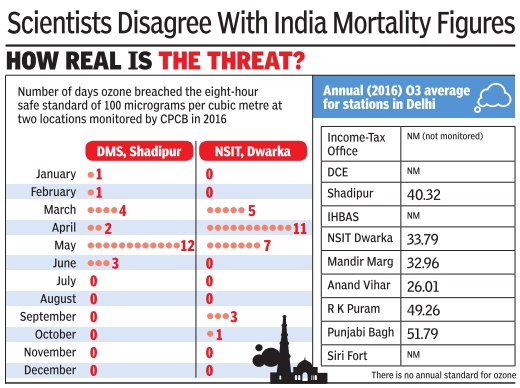
Reacting to a recent international report that said India had the highest number of ozone-related deaths, scientists from the Central Pollution Control Board said exposure to ozone cannot lead to premature mortality and that the report was only putting India on the spot with “observational data“.
In its “State of the Global Air 2017“ report, US-based Health Effects Institute (HEI) had analysed the impact on health of air pollution across the globe and found India had the most fatalities due to chronic obstructive pulmonary disorder (COPD) caused by ozone.
The report said 2.54 lakh deaths occurred in 2015 globally on account of ozone exposure, of which India accounted for over more one lakh and China, 71,900. The report also said India's record contributed substantially to the 67% rise in ozone attributable COPD deaths since 1990.
Refuting the findings, Dipankar Saha, head of CPCB's air lab, said, “Ozone exposure cannot be linked with mortality. If it were true, by now we would have seen a very large number of deaths in the US, which has high ozone concentrations. Our data shows India rarely exceeds the safe standard for the gas.“
While CPCB shared annual average concentrations of the highly hazardous and reactive gas for 33 cities and 56 stations, though not the daily or monthly concentrations, experts who declined to be quoted said annual concentrations could mask ozone peaks.Ozone is formed when nitrogen dioxide emissions react with volatile organic compounds in hot weather.
Contradicting even the death figures associated with respirable pollutants in the HEI report, Saha said, “It's an observational study . Our data is robust and comparable becau se India is the only country that has specified pollution measurement methods and techniques.“ S Scientists TOI spoke to also confirmed that proof of ozone's link with mortality is only now being studied. “Current research only looks at ozone's association with worsening COPD, asthma and inflammation and increased risk of premature mortality ,“ a public health expert pointed out. “The link is strong, but stronger evidence base is necessary before a conclusive declaration can be made.“
Referring to the report, Union environment minister Anil Madhav Dave too had pointed out, “These reports are often based on extrapolations without due scientific validation and there is a need for caution before arriving at any conclusion.“
The HEI report stated that “over the last 25 years, India experienced a nearly 150% increase in ozone-attributable deaths, while China's number remained about the same. The ozone-attributable COPD mortality rate decreased by about 1% over this time period in the United States and Indonesia, and remained relatively stable in Russia and the European Union“.
CPCB's own “Epidemiolo gical study on effect of air pollution on human health in Delhi“, published in 2012, admitted that the combustion of fuels produced outdoor pollutants, including ozone. “There is increasing evidence to suggest that exposure to these pollutants elicits adverse health effects often at levels well below the current WHO guidelines,“ the report said.
The “Delhi commitment on multi-sectoral action for addressing air pollution“, the result of a workshop organised by the union environment ministry and WHO, recommends making air pollution impact assessment mandatory for public policies of various ministries. It also advises investment of “additional human and financial resources“ to reduce exposure to air pollution.
Metropolitan cities, 2015-16
The Times of India, Apr 29 2016
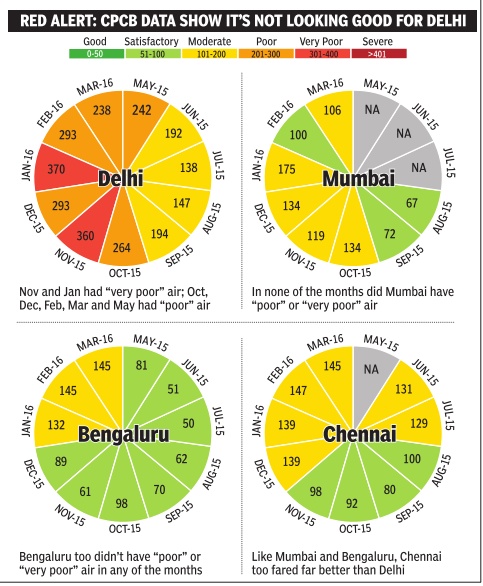
Delhi's air most foul among metros
The Central Pollution Control Board (CPCB) released national air quality index (NAQI) status for 24 cities in 10 states.
The report provided daily AQI values for 11 months for most major cities and for 4-6 months for others that CPCB started monitoring later. Data showed that Delhi, Varanasi, Lucknow and Kanpur had a large number of days with very poor and severe air quality whereas the coastal and southern states fared better. But there is a huge disparity in the number of monitoring stations in each city. Here, we compare the air quality in Delhi with Mumbai, Bangalore and Chennai. Delhi has nine monitoring stations. Mumbai had just one station functioning on Thursday, Bangalore had 5, and these differences will have to be factored in.
Delhi had two months of “very poor“ and five months of “poor“ air (see graph). Mumbai had no months in the “poor“ or “very poor“ categories, nor did Bengaluru or Chennai.Experts said meteorological factors play a crucial role in this --while coastal cities have better dispersal of pollutants, Delhi, Kanpur, Varanasi and others in the Indo-Gangetic plains are worse off because of higher emission sources such as industries, brick kilns and others. The CPCB's report also indicates that the monitoring is very weak in certain parts with many cities showing “no data“ for several days. Gurgaon, for instance, had AQI only for a day in all of January . This indicates the report gives a skewed picture in these cities
Ozone levels
2014
The Times of India, Sep 09 2016
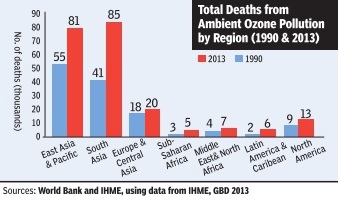
Jayashree Nandi 10-20% rise in ozone levels in India, harmful for lungs and crops: Report
While Indian cities are still grappling with the impacts of severe particulate matter (PM) pollution, a new report has raised the flag on ozone levels (O3) too. `The Cost of Air Pollution', a report by the World Bank and Institute of Health Metrics and Evaluation (IHME) released, estimates that the concentrations of O3 has increased by 10 to 20% in India between 1990 and 2013. The trend is similar in neighboring countries and in Brazil, while a declining course was seen in the US and Indonesia, among others.
High ozone levels are not only associated with serious health impacts like reduced lung function, chronic obstructive pulmonary disorder (COPD), aggravating asthma and respiratory conditions, but also with widespread crop loss.
The study also estimates that total deaths due to increase in exposure to O3 increased by 50% between 1990 and 2013 in South Asia. For this report, the health and economic burden of O3 is only based on COPD incidence from it. Total deaths due to exposure to PM2.5 have also increased in South Asia during the same phase, but not as steeply as with O3.
Interestingly, even though the cost of O3 related premature deaths are far lower than that of PM2.5 (both household and outdoor), O3 associated economic or welfare losses for South Asia are equivalent to that of North America. The welfare losses due to O3 exposure are to the tune of 0.4% of gross domestic product (GDP) equivalent, the report states.If you consider man days lost, it's about 0.09% of GDP equivalent, it says.
Air quality experts said O3 could be a serious concern soon. “Even before we could deal with health damage from particulate pollution we are falling into the pincer grip of ozone pollution that damages both lungs and crops. This is also the sign that emissions of toxic gases are increasing rapidly in our country . Keep in mind that for estimating health damage from ozone this report has only considered chronic obstructive pulmonary diseases. The actual cost of health damage could be way higher,“ said Anumita Roy Chowdhury , head of Centre for Science and Environment's clean air programme.
Ozone is not directly emitted from any source, it is created by chemical reactions between oxides of nitrogen and volatile organic compounds in the presence of sunlight. It's mainly released from combustion sources which includes vehicles and industries.
A 2014 study by scientists at Indian Institute of Tropical Meteorology estimated that ozone-induced damage to wheat and rice is enough to feed roughly 35% of 270 million BPL population in India.
2015: India tops
Vishwa Mohan, Country Can't Continue In Denial: Experts, Feb 15, 2017: The Times of India
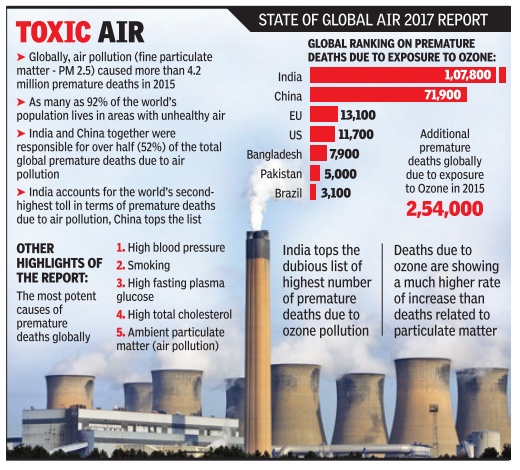
India tops list of countries in ozone pollution deaths
India has been in denial mode on linking premature deaths to air pollution in the absence of conclusive data, but a new comprehensive global report by two US-based institutes may now trigger a rethink. The report claims the country's worsening air pollution caused some 1.1 million premature deaths in 2015 and it now rivals China in having among the highest air pollution health burdens in the world.
The State of Global Air 2017 report, released in Bos ton on Tuesday , claims longterm exposure to fine particulate matter (PM2.5) -the most significant element of air pollution -contributed to 4.2 million premature deaths in the world in 2015 where both India and China to gether were responsible for over half of the total global deaths. Though the report sounds alarm bells for entire Asia, it paints a particlularly grim picture for India where the rate of increase of premature deaths due to air pollution is even higher than in China. It noted that while the early deaths related to PM2.5 in China has increased by 17.22% since 1990, it has increased by 48% in India.
Ozone-related early deaths in India are, in fact, 33% higher than those recorded for China. India's deepening pollution problem, which hit home with a vengeance after Diwali last year as Delhi and NCR woke up enveloped in smog that refused to lift for days, has a death toll second only to China's, and together the two nations acount for over half the world's deaths from pollution. According to the State of Global Air 2017 report, released in Boston on Tuesday , as many as 2.54 lakh deaths occurred in 2015 on account of exposure to ozone and its impact on chronic lung disease.India accounts for the highest number of premature deaths due to ozone pollution, its toll 13 times higher than Bangladesh's, and 21 times higher than Pakistan’s.
An interactive website on the report also highlights that 92% of the world's population lives in areas with unhealthy air. “We are seeing increasing air pollution problems worldwide, and this new report and website details why that air pollution is a major contributor to early death,“ said Dan Greenbaum, president of the Health Effects Institute (HEI), the research institute that designed and carried out the study . He said, “The trends we report show that we have seen progress in some parts of the world, but serious challenges remain“.
The report was prepared by HEI in cooperation with the Institute of Health Metrics and Evaluation at the University of Washington and the University of British Columbia. Involving more than 2,000 researchers, the report factored in the role of an extensive set of behavioural, dietary and environmental risk factors for more than 300 diseases in 195 countries from 1990 onwards.
Referring to the findings of the report, Anumita Roychowdhury of the Centre for Science and Environment, said, “India can't afford to remain complacent or in denial. With so many people dying early and falling ill... due to particulate and ozone pollution, it is a state of health emergency . This demands nationwide intervention to ensure stringent mitigation and a roadmap to meet clean air standards“.
Region-wise
Northern plains, pollution
The Times of India, May 13 2016
Amit Bhattacharya
The northern Indian plains have again come into focus as one of the globe's most-polluted regions, with nine of the world's 20 most polluted cities in the 2016 WHO urban air pollution database from this swathe of land. What make this region's air so foul? It's a confluence of factors, say experts, with geography , climate, population, agricultural practices as well as fossil fuel emissions all playing a part.
“A major reason for high pollution in the Indo-Gangetic plains is its geography. Located next to the Himalayas, this is a wind convergence zone which transports pollution from other places into these region,“ said Gufan Beig, project director of System of Air Quality and Weather Forecasting and Research (SAFAR), which monitors air quality in a number of cities.
The convergence factor shows up the most in winters, when the region sees spells of dense fog due to cold winds coming from the west. Fog traps pollutants, leading to sharp deterioration in air quality .Cold winds also leads to `inversion', wherein pollutants are trapped near the surface.
The northern plains also have among the highest population densities in the world.This translates to higher pollution from human activities.“The other major source of pollution is the practice of crop burning. During winters, soot from these fires hang in the air longer. The region also sees high use of coal and wood, which are very polluting, for cooking,“ Beig said. Ironically, the region's fertile alluvial soil, which attracted people to this belt, also contributes to its pollution. Alluvial soil is highly dusty when dry , say experts.
“Many parts of this region do not get much rain -the average for Delhi is 40 days in a year -which is why these places are very dusty ,“ said a CPCB official.
These natural causes have combined with growing vehicular and industrial emissions to make the plains the pollution hotspot of the world.
Season-wise
Winter
Air no good in any of winter months: Study, March 18, 2017: The Times of India
89% Of Days In `Poor' Category
The Centre for Environment and Energy Development (CEED) on Friday released a report on `ambient air quality of Delhi' for winter months, which depicted alarming levels of PM 2.5 in the capital between November and February .
Not a single day in the four-month-long winter season was noted under the “good“ air quality category , while a whopping 89% of the total days fell into either the “poor“ or “very poor“ categories of the graded response action plan (GRAP) notified by the Supreme court.The report also noted that 6% of the total winter days fell into the “severe“ category, with PM 2.5 levels between 250-300 microgramscubic metre.
According to the report, 981 microgramscubic metre was the maximum 24-hour average concentration of PM 2.5 observed, which was recorded at the monitoring station of Delhi Technologi cal University (DTU) near Bawana Industrial Area on November 5. This is 16 times higher than the prescribed limits of 60 microgramscubic metre for the 24-hour rolling average of PM 2.5. “The air quality of the city was unbreathable and is choking its residents, especially those more vulnerable to it. It is a crisis looming at our faces and we cannot turn a blind eye to it. GRAP is the way forward and will help in improving the situation,“ said Dimpy Suneja, programme officer, CEED.
The findings have been based on data collected from 10 real-time air monitoring stations in Delhi, set up by the Central Pollution Control Board (CPCB). The findings were recorded between November 2016 and February 2017 from stations including ITO, Anand Vihar, Mandir Marg and Punjabi Bagh. The report also revealed that the monthly mean values showed a downward trend from November onwards.
Stoves (chulhas) pollute villages
The Times of India Jan 09 2016
Vaishnavi Chandrashekhar
New Study Calls For Integrated Approach That Focuses On Reducing Exposure Not Emissions
Who's more affected by toxic air: A young executive in New Delhi or a housewife in a Haryana village?
One might assume the executive is worse off -after all, Delhi has the world's worst air. Yet a village woman who cooks over a dung-fuelled chulha for several hours a day could be more exposed to hazardous pollutants than a Delhi office worker.
This distinction between ambient pollution levels and individual exposure lies at the heart of a new report from a Union health ministry committee that -correcting a historical focus on urban air pollution -highlights the importance of tackling pollution from the burning of dung and wood in village chulhas across India.
The report, made available on the health ministry's website this week, calls for an integrated approach to air pollu tion that focuses on “reducing exposures not emissions“.
“All pollution is bad but, with the intention of eventually taking care of all of it, where do you focus your efforts first?“ said Ambuj Sagar, committee co-chair and Vipula and Mahesh Chaturvedi Professor of Policy Studies at the Indian Institute of Technology in Delhi. “From a health standpoint, you prioritise reduction in areas and sources that most affect people directly.“
Top of the committee's list: reducing household air pollution from cooking with biomass because the proximity to humans makes stove smoke most harmful -next only to cigarette smoking.
Household cooking is “probably the largest single source of exposure in the country , although only one of many contributors to ambient air pollution,“ the report said.Most rural households in India, an estimated 780 million people, continue to rely on wood, dung and other biomass for cooking, while a good percentage of urban households also use non-LPG stoves.
Next on the committee's priority list: pollution from vehicles, garbage burning, and diesel generator sets -all micro or local sources of pollution. Then comes road and construction dust, followed by brick kilns, local industries, and then power plants and other large industries. Conventionally , environmental policy has focused on large-scale sources of ambient pollution. Road dust, for example, is thought to be a bigger source of pollution in Delhi than vehicles.
“The standard practice of ranking pollution sources on the basis of their contribution to ambient emissions...may be creating distortions in their apparent relative importance from the health standpoint, although perhaps adequate for other purposes -visibility , for example,“ the report says.
“Evaluation by exposure will not only re-order the ranking of major outdoor emission sources but will reveal an entirely different landscape of sources; those that may significantly affect exposure without appreciably affecting ambient concentration.“
Much more data and studies are needed to understand pollution patterns, Sagar said.Monitoring of air pollution is still largely confined to cities, the report notes, and monitors tend to be on rooftops “where people hardly ever are“.
To reduce household pollution, the report advocates expanding power and gas coverage as well as innovating cleaner stoves and running public health campaigns.Tackling air pollution should be part of the Swachh Bharat campaign, the committee said.
Emissions from cooking with biomass also contribute a quarter of ambient PM2.5 levels in the country , the report notes.
Vehicular emissions
Emission test norms lax: CSE
Emission test norms lax: CSE The Times of India, Feb 4, 2017

Only 5% of 3.93 lakh vehicles checked at 614 pollution under control (PUC) centres in Delhi between January 1 and 25 failed the emission test, according to data released by Centre for Science and Environment (CSE). While this may seem like great news given the poor air quality in the capital, the tiny fail percentage raises serious questions about the efficiency of the system.
CSE researchers claim the data gathered from the transport department only show a huge inefficiency in dealing with vehicular emissions through the PUC system. The PUC norms for onroad vehicles are extremely lax for the older or pre-BS-IV vehicles. For diesel vehicles, only a smoke density test is carried out, which are particularly lenient--for BS-IV compliant vehicles, the norm is 50 hartridge smoke density (HSU) and 65 HSU for pre-BSIV vehicles.
The norm in Singapore and Pakistan is 40 HSU while it is 50 HSU in Indonesia, Thailand, Hong Kong and Malaysia. “It's like the norm itself is meant to catch the absolute worst offender. Why not also catch the other bad ones,“ asked a CSE researcher. Participants at a round-table on “Reinventing in-use emissions compliance regime“, held on Friday , discussed how not only were the standards lax, but there was too much corruption in the system.
“They (PUC centres) clear the vehicles because they will not get the money for the test otherwise. We have seen it happening several times,“ said a CPCB official present at the meeting.
The Supreme Court has directed the Environment Pollution Control Authority (EPCA) to audit all the 614 PUC stations. An audit carried out by CPCB in 2013 at 76 PUC centres had also exposed a number of anomalies, including non-compliance of the code of practice, poor condition of the laboratories, non-functioning analysers.
The CSE round-table also flagged the fact that the PUC system was not even designed to test tiny particles and oxides of nitrogen (NOx) emissions.
Carbon emission intensity
2005-10: emissions reduced by 12%
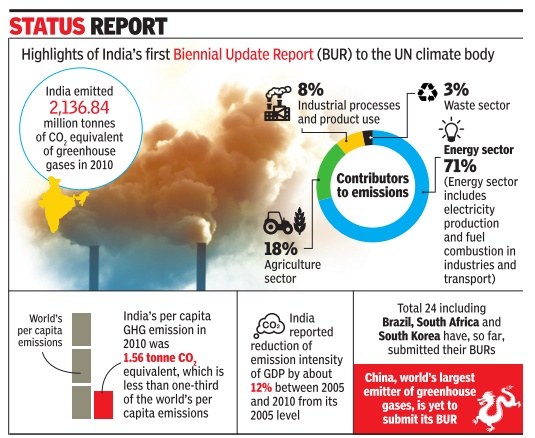
Sources:
1. The Times of India, January 23, 2016
2. The Times of India, January 23, 2016, Vishwa Mohan
India emission down 12% in five years India is on course to fulfil its global commitment, having voluntarily cut its carbon emission intensity (emission per unit of GDP) by about 12% between 2005 and 2010, according to its report submitted to a UN climate body , reports Vishwa Mohan. The result shows the country is in line to reach its 20-25% reduction target by 2020 and subsequently the 33-35% emission intensity reduction goal by 2030 as promised by it. Just weeks after the Paris deal of December 2015, India submitted its first Biennial Update Report (BUR) to a UN climate body highlighting that the country is well on course to fullfil its global commitment by voluntarily cutting its carbon emission intensity (emission per unit of GDP) by about 12% between 2005 and 2010. The result appears encou raging as it shows that the country is in line to reach its 2025% reduction target by 2020 and subsequently the 33-35% emission intensity reduction goal by 2030 as promised by it in the country's climate action plan to the UN body . The BUR was submitted by India under its obligation to inform the United Nations Framework Convention on Climate Change (UNFCCC) about its action on the ground to deal with the challenges of climate change. As per the provisions of the Convention, countries need to periodically provide information in the form of their National Communication'.
The Paris climate agreement, reached by 195 countries on December 13 last year, had called for developing countries to submit their first biennial update reports as soon as possible. So far, 24 developing countries including Brazil, South Africa and South Korea have submitted the ir BURs. China, the world's largest emitter of greenhouse gases, is yet to submit its report. Brazil has submitted its report, but has given only provisional inventory .
Developed countries, on the other hand, are required to submit a report known as the Biennial Report (BR), which is to be submitted every alternate year and is subjected to International Ana lysis and Review (IAR). But, the BURs of developing countries are subjected to an international process known as International Consultation and Analysis (ICA). It is a process that includes international scrutiny of BUR in a manner that is “non-intrusive, non-punitive and respectful of national sovereignty“.
India's BUR was prepared by the ministry of environ ment and climate change in consultations with various public and private institutions. It was approved by the Union Cabinet on Wednesday .According to India's BUR, the country had emitted 2,136.84 million tonnes of CO2 equivalent greenhouse gases in 2010.About 12% of the emissions were, however, offset by carbon sink action of forests and croplands.
Car emission testing
Serious flaws: CSE, 2017
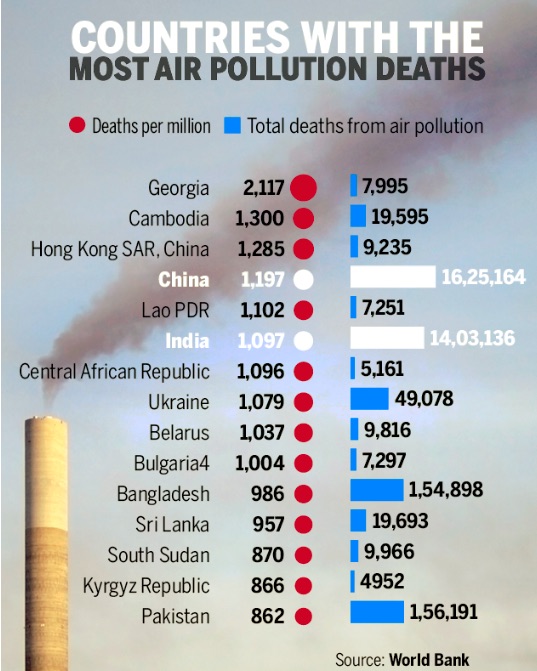
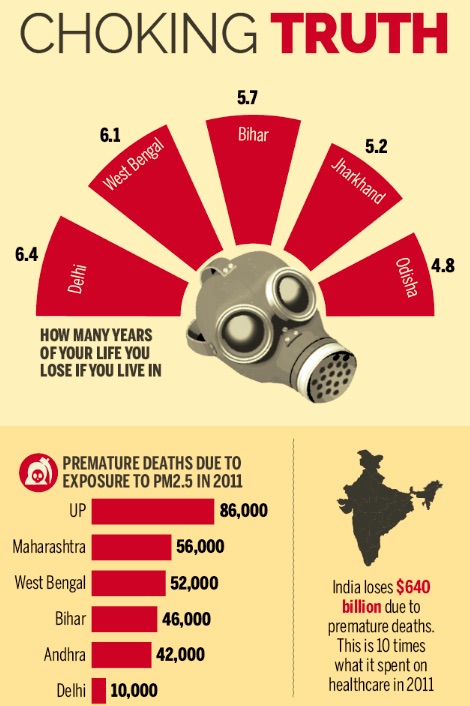
HIGHLIGHTS
A Centre for Science and Environment (CSE) report urges for urgent steps to upgrade the current in-use emission testing
It says PUC centres must be checked, testing procedure upgraded and auto makers made accountable
CSE warns of alarming consequences if current situation continues to prevail
One of the biggest corporate frauds in the global automobile industry - the Volkswagen defeat device case - and the mounting evidence from Europe that most new diesel cars are emitting much higher than their certification levels, have largely gone unnoticed in India.
Centre for Science and Environment (CSE) has strongly urged for urgent steps to upgrade the current in-use emission testing, prepare for real driving emission testing with portable emission monitoring systems for Euro VI vehicles and make vehicle manufacturers liable and accountable for emission performance of vehicles during their useful life on the road.
The current practice of pollution under control programme (PUC) is rudimentary and ineffective. It is not designed to address complex emissions control systems in new vehicles. This cannot screen inherent technical flaws and frauds for which manufacturers are responsible that compromise the emissions performance in the real world.
The key highlights of the CSE analysis:
Very poor PUC compliance and ineffective tests
The PUC system, the only system to check emissions from on-road vehicles in India is extremely weak in terms of lax norms, poor enforcement and poor quality test procedures. New data from the Delhi Transport Department shows that failure rate is as dismal as 5 per cent - nearly all vehicles pass the test. There is no data, however, on how many vehicles show up for the test. The PUC norms for on-road vehicles are extremely lax for the older pre-Bharat stage IV vehicles. While under PUC, petrol cars are tested for carbon monoxide and hydrocarbons along with lambda (that indicates the optimum condition needed for proper functioning of catalytic converters), diesel vehicles are tested only for smoke density. While all norms are lax, those for on-road diesel vehicles are particularly lenient - smoke density norms are 50 HSU only for the Bharat Stage IV-compliant diesel vehicles. For pre-BS-IV vehicles, the norm is as lax as 65 HSU. In Singapore and Pakistan, this norm is 40 HSU; in Indonesia, Thailand, Hong Kong and Malaysia it is 50 HSU for all genre of vehicles. This is a serious issue at a time when Delhi, which already has more than 614 PUC centres, is trying set up more. This investment can go waste without an effective system in place.
Serious concern over quality of checks in PUC centres
The Supreme Court has recently given directions to the EPCA to audit all the 614 PUC stations. There are serious concerns over quality and credibility of PUC tests across the cities. In fact, a detailed audit that was carried out by the Central Pollution Control Board in 2013 in 76 PUC centres exposed serious anomalies - non-compliance with the code of practice; unavailability of calibration certificate for testing instruments in several centres; poor condition of laboratory; leak test failure; and non-functioning analysers. This clearly brings out the ineffectiveness of the programme.
Smoke density test under PUC cannot check particulate emissions
The smoke test was introduced in the 1960s to reduce the visibility problems due to diesel smoke. There is no real correlation between smoke density and particle emissions. Smoke is not a good surrogate for tiny particles. There can be a risk of misclassifying polluters - low smoke emissions can also mean high particulate emissions. Even in Europe, virtually no vehicle fails the smoke test. Other governments including ones in China, Hong Kong, Singapore, the US, etc now conduct these tests on chassis dynamometer to simulate speed. This makes the emissions test more rigorous. China is further developing a nationwide I/M system for evaluating NOx emissions from in-use HDVs. Tests are needed to prevent emissions frauds or poor emissions performance of advanced emissions control systems on roads - especially diesel vehicles The PUC system is not even designed to test tiny particles and NOx on road - the key concerns from diesel vehicles. Volkswagen was caught cheating on NOx emissions. In fact, too much focus on reducing smoke can actually increase NOx emissions as a trade-off. But new generation diesel vehicles will come with advanced emissions control systems to reduce particulate and NOx. If these systems perform sub-optimally, there can be uncontrolled emissions. The fact that India is totally unprepared to prevent emissions frauds and underperformance of emissions control systems on roads was proved a few years ago when the Tavera fraud case of General Motors was exposed. These models passed the certification tests with one set of engines that did not the match those actually sold in the market. But this incident did not lead to any major reform to establish in-use compliance norms and monitoring in India.
The Indian government does not have the power to penalise manufacturers for non-compliance and violation. This has serious implications as the next level of Euro V and Euro VI standards will require advanced particulate traps and NOx control systems like SCR to cut toxic diesel emissions. If engineering deficiency reduces the effectiveness of these systems or if these are not properly operated like urea refilling in SCR system, it can lead to uncontrolled emissions and nullify pollution control measures in our cities. India has already specified more advanced On Board Diagnostic Systems in post-2013 vehicles. This should be integrated with vehicle inspection programme for more effective monitoring.
If a problem or malfunction is detected, the OBD II system illuminates a warning light on the vehicle instrument panel to alert the driver. This warning light will typically display the phrase "Check Engine" or "Service Engine Soon," and will often include an engine symbol. The OBD system stores important information about any detected malfunction so that a repair technician can accurately find and fix the problem. It is notified to monitor catalyst, fuel injection system, particulate trap, coolant temperature, EGR, fuel system, emission control systems, etc. Smog-check inspections in USA for post-2000 model vehicles are now primarily based on an inspection of the OBD II system - tailpipe testing is no longer required. It identifies emission-related components covered under warranty, eliminates unnecessary repairs, and gives information about area of malfunction or a specific component. This reduces cost of warranty repairs and ensures customer satisfaction, allows early detection of malfunctions etc. But this system will require strong surveillance and appropriate software to work effectively.
Auto company and its accountability
India also needs strong compliance regulations to make manufacturers responsible for on-road emissions performance for a vehicle's useful life on road Consistent with the global best practices, India needs an independent authority to check emissions against standards; issue recall of vehicles by companies if they are found non-compliant; levy fines on defaulting companies; and withdraw approval of sale if vehicles do not conform with the stated emissions targets. An independent authority should monitor this process without being influenced by industry. Only such a system will make non-compliance with regulations more expensive for companies than compliance with regulations and ensure implementation. The Auto Fuel Policy committee has recommended an emissions warranty and recall programme and in-use compliance regulations. But this has not been implemented.
CSE's review shows that currently, Indian certification agencies do not select vehicle samples for certification tests randomly and independently. In fact, certification agencies give prior notice to manufacturers about the approximate time during which samples will be collected from a given lot. This compromises independent and impartial testing. Legal procedures for the MoRTH to issue mandatory recalls or levy fines have not been established yet. Moreover, there is no system post-sales (as in the US) to allow testing agencies to select any vehicle, anywhere, and at any time, without prior notice to the manufacturer. India urgently needs rules for the government and manufacturers to remove non-compliant vehicles. A mandatory recall policy for non-compliant vehicles is needed to ensure that manufacturers design vehicles to comply with emission standards for the duration of their useful life. In fact, China has taken steps to move in this direction. China has recently revised its programmes to allow the selection of vehicles at random without any prior notice. Furthermore, COP testing in China is now corroborated through inter-laboratory round-robin testing, which adds an additional level of scrutiny.
Where the problem is the gravest
Bus travellers inhale less soot than those in cars
Commuting by bus in Delhi exposes you to the lowest concentrations of fine-particle pollutants called black carbon, or soot, as compared with other modes of transport -even lower than the exposure you are likely to get travelling in a car, a study reveals.
The study , published in Elsevier journal on environmental research, assessed people's personal exposure to pollution in Delhi. For outdoor exposure, it considered commuters in cars, buses and autorickshaws.
Travellers in autorickshaws were found to be at the highest risk of inhaling soot, a product of incomplete fuel combustion with harmful impacts on the lungs and heart.
“Exposure to particles is lower in cars than on two-wheelers and autorickshaws, but driving a car with open windows could lead to similar levels (of exposure) as in an auto,“ said Pallavi Pant, lead author of the study . Pant admitted that the find ings on exposure to pollu tion inside a car was surprising. “From the current analyses, black carbon concentrations in buses seem to be lower in comparison to other modes, but more research is needed to confirm this, both in Delhi and other cities. AC use can help reduce exposure in cars,“ she said.
It's not only being out on the roads that exposes you to respirable pollution particles.Your home, especially the kitchen, could be enveloping you in PM2.5 pollutants too, the study said.
It found high exposure to PM 2.5 pollutants in indoor activities such as cleaning or cooking. However, the nature of pollution indoors differs from that outdoors. According to Pant, exhaust emissions on the roads could be far more toxic than say pollutants arising from cooking or cleaning.“Cooking emissions often comprise ultrafine particles that can be harmful,“ Pant said. “Research on ultrafine particles is ongoing, but so far we know they can have several adverse health effects.“ Pant suggested opening the windows and using exhaust fans during cooking or cleaning to avoid accumulation of such pollutants.
Buses, because they use CNG as fuel in Delhi, do not emit soot and are safer. Also, bus passengers sit at an elevated height compared with autorickshaws and cars and avoid the denser pollution layer near the road surface. In cities where buses run on diesel, they may , however, show higher levels of black carbon. An in-depth analysis is required to confirm this.
The authors, from the University of Massachusetts, Amherst, IIT Delhi and University of Washington, have suggested more studies on in-vehicle exposure. “Future studies should look at in-vehicle exposure with respect to land use and traffic characteristics, and personal exposure data should be used as an input for land use zoning and urban transportation planning,“ the study concluded.
The researchers worked with healthy volunteers, men and women, aged 18 to 60 years.Their individual exposure to pollution was sampled using portable sampling devices.Commute exposure was recorded on a 22km sampling route, including a section of the busy Mathura Road-National Highway 2, during peak hours (810am and 68pm) and offpeak times (12 noon-2pm). Most volunteers were non-smokers and all used LPG as cooking medium at home. They spent 40-90 minutes commuting daily and 8 to 10 hours at work.
The study also reported that pollution risk is higher in winter than in summer. “The pattern for personal exposure to particles is similar to ambient air quality , and can be as much as six times higher than the national air quality standard in winter,“ said Pant.
See also
Air pollution: India
